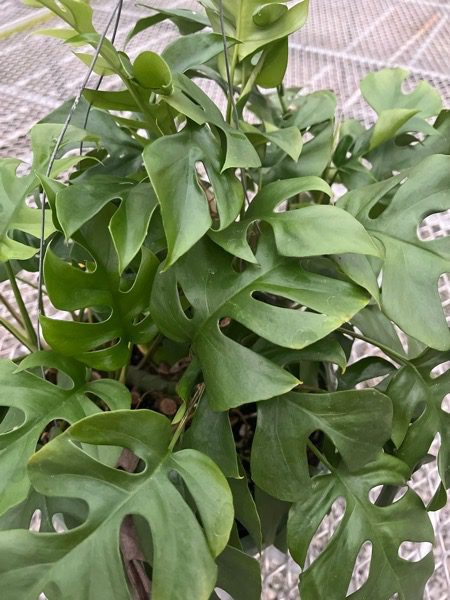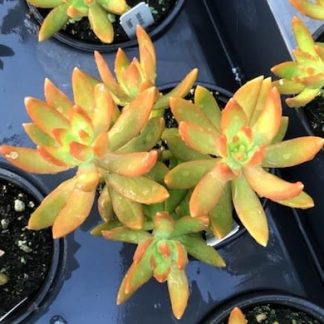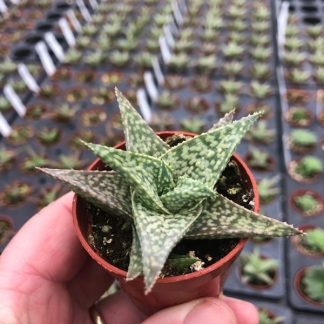Description
Welcome to the World of Rhaphidophora tetrasperma
Mini Climbing Monstera
Rhaphidophora tetrasperma, often nicknamed the Mini Monstera or Ginny Philodendron, looks as if someone took a giant Monstera deliciosa and pressed the “shrink” button. The leaves split and curl just like their famous cousin, but each blade fits in the palm of your hand. Because this plant matures quickly and climbs with enthusiasm, it has become a beloved companion for homes, classrooms, and cozy offices everywhere. In other words, you get tropical drama without needing a jungle-sized room.
Below, we’ll wander through its story, admire its charm, and, most of all, learn how to help it climb, thrive, and amaze. Ready? Let’s grow together.
Meet Your Mini Marvel
A Quick Description
- Leaf Style: Bright green, glossy, and deeply split. Each lobe feels smooth yet sturdy.
- Growth Habit: A natural climber that sends out aerial roots along its stem. When you give it a pole or trellis, it races upward.
- Size: Indoors, the vine usually reaches 4–6 feet tall, though it can stretch farther with time. Leaves stay compact, averaging 4–6 inches long.
- Speed: Fast! You might spot new leaves every few weeks in ideal conditions.
Because of the plant’s mini size and bold leaf texture, it fits nicely on bookshelves, plant walls, and windowsills. It also partners well with trailing vines and bushy ferns, making mixed displays feel lush.
Plant Origins and Natural Habitat
Rhaphidophora tetrasperma hails from the humid forests of southern Thailand and Malaysia. There, it climbs tree trunks in dappled light while monsoon rains drench the roots. Instead of soaking in constant sun, it enjoys bright, filtered rays that flicker through the canopy. Understanding this background helps us recreate the right conditions at home. After more than a few seasons of observation, growers agree: mimic the edge of a rainforest and you’ll make your Mini Monstera smile.
Why We Adore It
- Space-Saving Charm
You get iconic Monstera fenestrations without needing a corner of your living room all to itself. - Instant Tropical Feel
Even a single vine turns a dull room into a leafy retreat. Place it near a woven basket, and suddenly the décor feels intentional and warm. - Climbs, Trails, or Hangs
Offer a moss pole, and it ascends gracefully. Let it dangle from a shelf, and it cascades like a green waterfall. You decide the style. - Easy Propagation
Snip a node, pop it in water, and roots appear quickly. Sharing cuttings with friends fosters connection and reduces plant costs. - Forgiving Nature
It bounces back from minor neglect. Forget one watering? Leaves may droop but soon recover.
In other words, Rhaphidophora tetrasperma rewards care yet understands busy schedules. That balance makes it ideal for both beginners and seasoned collectors.
How to Care for Your Mini Climbing Monstera
Light: Bright Yet Gentle
- Aim for bright, indirect light all day.
- Morning sun from an east window works wonderfully.
- Harsh afternoon rays can scorch leaves, causing pale spots or crispy edges.
- If a room feels dim, supplement with a full-spectrum grow bulb for 10–12 hours daily.
Tip: Rotate the pot weekly. Even growth prevents lopsided vines and keeps fenestrations symmetrical.
Water: Steady, Not Soggy
- Check moisture by pressing a finger one inch into the topsoil. If it feels dry, water thoroughly.
- Allow excess liquid to drain out completely. Never leave roots sitting in water.
- In warm months, expect to water every 5–7 days. During cooler seasons, stretch intervals to 10–14 days.
- Watch leaves for cues: gentle droop equals thirst; yellow tips often signal overwatering.
Humidity: A Tropical Treat
- Target 50–60 percent humidity.
- Cluster plants together, use a pebble tray, or run a small humidifier nearby.
- Instead of daily misting—which can invite leaf spots—focus on consistent ambient moisture.
Temperature: Warm and Stable
- Ideal range sits between 65–85 °F (18–29 °C).
- Protect from drafts, sudden chills, and heaters that dry the air.
- Night dips below 60 °F (15 °C) slow growth but rarely cause lasting harm if brief.
Soil: Light, Airy, and Rich
- Mix two parts high-quality potting soil with one part orchid bark and one part perlite.
- This blend drains well, stays fluffy, and allows oxygen to reach the roots.
- If you prefer ready-made, choose aroid or Monstera soil blends that balance moisture and airflow.
Feeding: Gentle Nutrition
- During spring and summer, feed once a month with a balanced liquid fertilizer at half strength.
- In fall and winter, pause feeding unless you see active new growth.
- Flush soil with plain water every few months to prevent salt build-up.
Pruning and Training: Shape the Climb
- Install Support Early
A moss pole or coco coir stake encourages larger leaf splits and sturdier stems. - Tie, Don’t Force
Use soft garden tape or twine to guide the vine upward. Gently loop around a node; avoid tight knots. - Snip for Bushiness
Cut just above a node to stimulate branching. Each cut often sparks two fresh shoots. - Regular Grooming
Remove yellowing leaves and spent aerial roots for a tidy display.
Repotting: Room to Grow
- Repot every 12–18 months, or when roots circle the pot’s base.
- Choose a container one size up (about 2 inches wider).
- Refresh soil to boost nutrients and aeration.
- Water lightly after repotting, then resume normal schedule once new growth appears.
Propagation: Share the Love
- Stem Cutting
Choose a section with at least one leaf and one node. - Water Method
Place the cutting in a jar of clean water. Change water weekly. Roots sprout within 2–4 weeks. - Soil Method
Dip the cut end in rooting hormone powder, then plant in moist, airy soil. Cover with a plastic dome to hold humidity. - After Care
When roots are 2 inches long, transfer water-rooted cuttings into soil. Keep moist but not soggy for the first month.
Common Problems and Simple Solutions
| Symptom | Likely Cause | Quick Fix |
|---|---|---|
| Yellow leaves, soggy soil | Overwatering | Let soil dry; reduce frequency |
| Brown crispy edges | Low humidity or hot sun | Boost humidity; shift to filtered light |
| Leggy stems, small leaves | Insufficient light | Move closer to a bright window or add grow light |
| Black spots at nodes | Fungal infection | Trim affected areas; improve airflow |
| Curling leaves | Underwatering or root bind | Check roots; water thoroughly; repot if crowded |
Instead of panicking, pause and observe. Plants speak through their leaves. When we listen, solutions come quickly.
Pet and Child Safety
Rhaphidophora tetrasperma contains calcium oxalate crystals that can irritate mouths and stomachs if ingested. Keep vines out of reach of curious pets and little ones. After more than one accidental nibble, pet owners find that a hanging planter or tall shelf works wonders.
Styling Ideas for Every Space
- Bookshelf Buddy: Train a single vine up a mini trellis tucked among novels.
- Window Cascade: Let stems flow down from a macramé hanger for a bohemian touch.
- Green Divider: Grow several plants along a narrow moss pole to create a natural room partition.
- Desk Accent: Use a petite cutting in a clear vase for a minimalist statement—roots swirling in water look artistic and calming.
Remember, foliage design is playtime for adults. Mix textures, colors, and pot shapes until the scene feels right to you.
Troubleshooting Checklist
- Light Check — Is the plant within two feet of bright, filtered sun?
- Moisture Check — Has the top inch of soil dried before watering again?
- Support Check — Do aerial roots have something rough to grip?
- Seasonal Check — When temperatures dip, water less and pause fertilizer.
- Leaf Check — Wipe dust monthly so leaves can photosynthesize at full power.
Use this list every few weeks. It keeps maintenance quick and prevents bigger issues down the road.
Community Propagation Project
Invite neighbors, classmates, or colleagues to exchange cuttings. A trimmed vine can become ten new plants, and a circle of friends gains ten shared stories. In other words, caring for Rhaphidophora tetrasperma becomes a team sport. Snap photos of progress, trade tips, and celebrate each unfurling leaf together. We grow friendships while we grow plants.
Beyond the Basics
Fun Experiments
- Moss Pole Misting: Spray the pole, and watch aerial roots dig in faster.
- Variegation Hunt: Rarely, a leaf emerges with creamy patches. If it happens, propagate that stem quickly.
- Air-Layering: Wrap damp sphagnum around a node still attached to the parent plant. Roots form without cutting first, boosting survival rates.
Sustainable Care
Use rainwater or de-chlorinated tap water to reduce chemical buildup. Compost spent leaves instead of tossing them. Choose organic fertilizers when possible. Small choices add up, making every leafy corner of your home a greener, healthier space.
Leafy Adventures Await
You now hold the keys to growing a vibrant, climbing Mini Monstera that lights up your day every time you walk by. With bright yet gentle light, balanced watering, and a sturdy pole to climb, Rhaphidophora tetrasperma rewards you with lush leaves and lively energy. Share cuttings, swap stories, and celebrate each new split leaf. Together, we’ll keep the canopy rising—one joyful node at a time.




